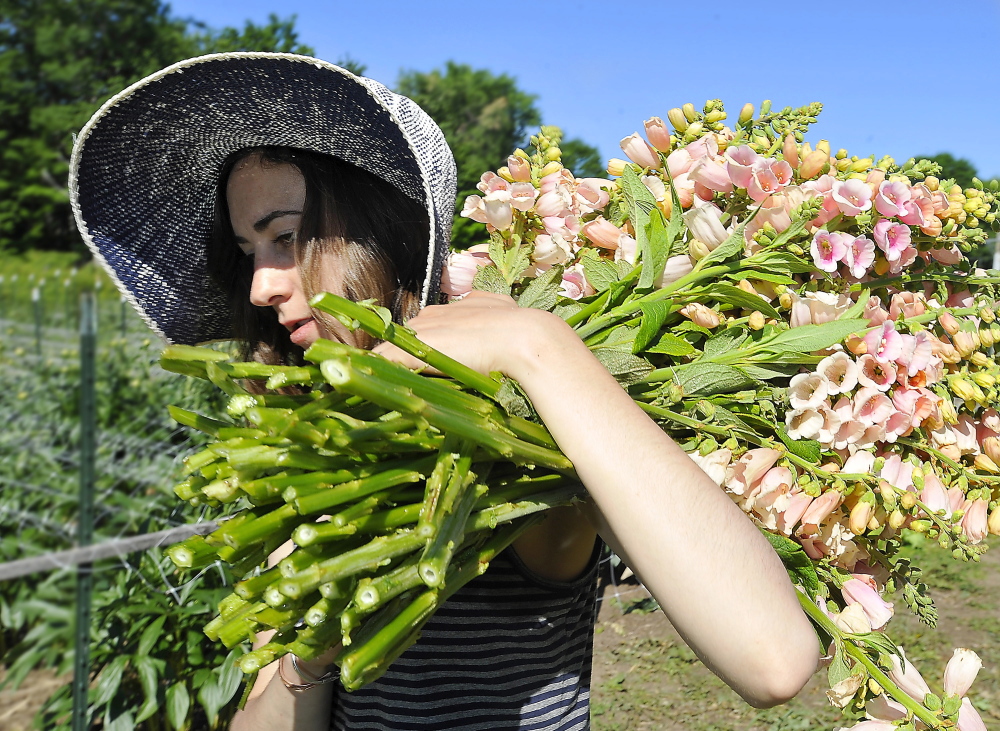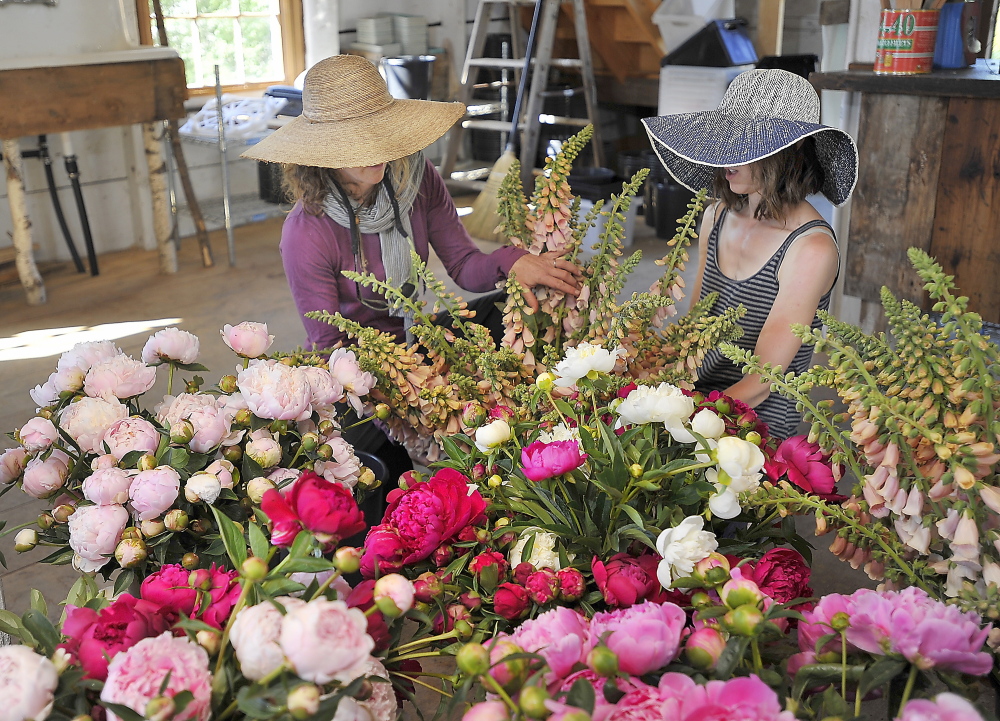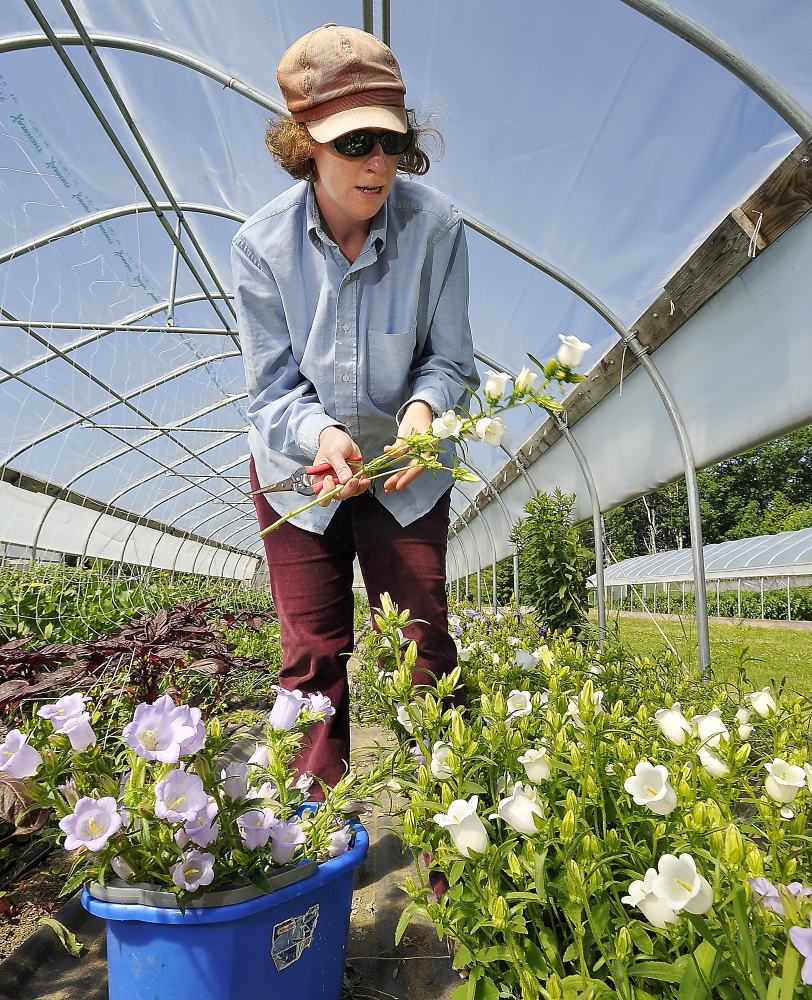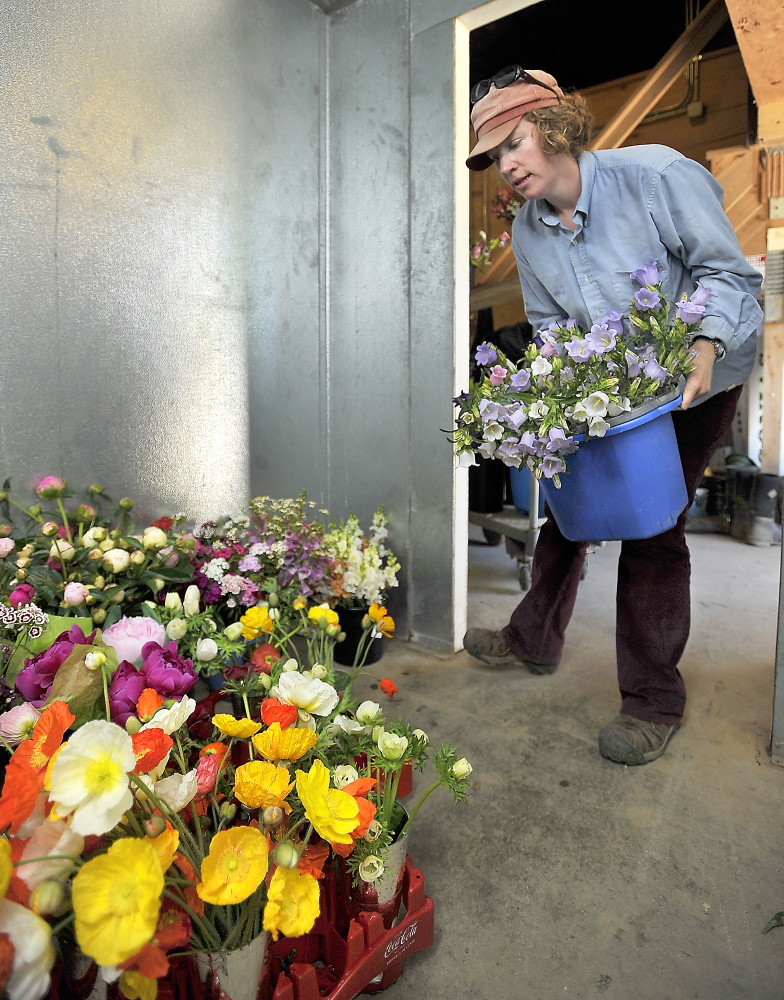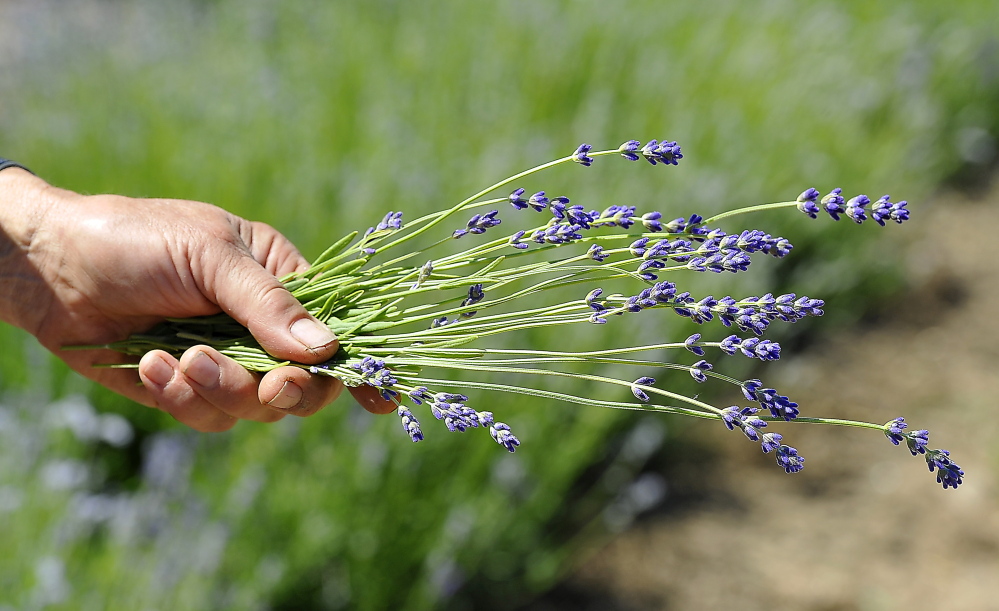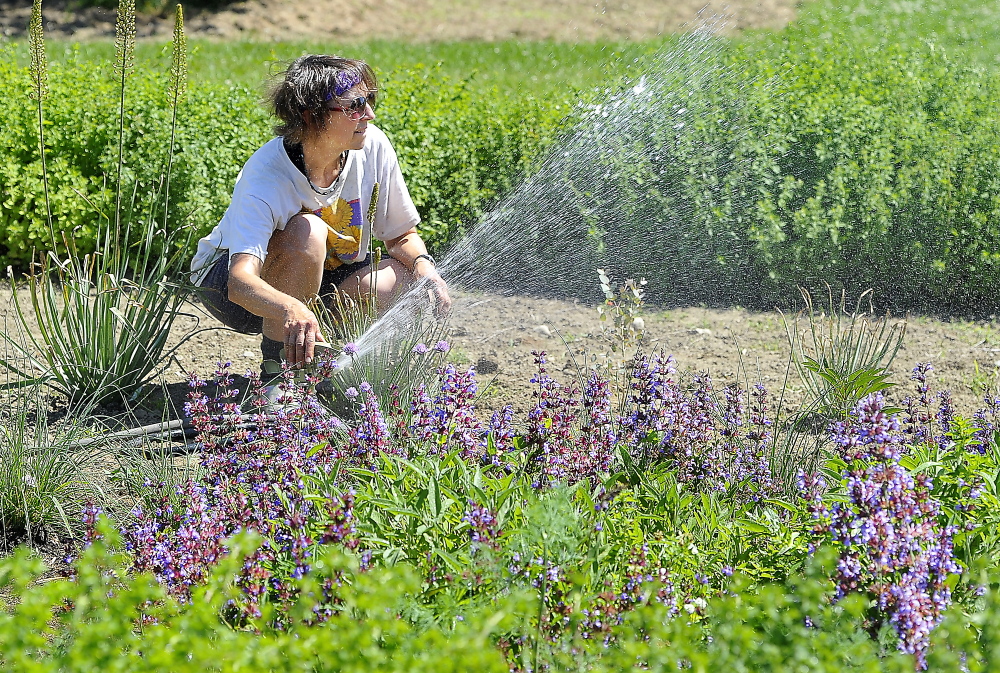Nancy Stedman and her husband, Bruce, bought a 110-acre defunct dairy farm in Buxton 20 years ago with simple ambitions: They’d have laying hens, grow vegetables and some flowers. “We told people, it’s going to be a gentleman’s farm,” Stedman said. They wanted a change from their busy lives running a printing and design business in Portland.
“People are just go-go-go,” she said. “We wanted a different life.” While she talked, she led a fast-paced tour through her gardens and hoop houses, where Little River Flower Farm’s main crop, flowers for the cut flower market, was in various stages of growth. The day was fine and the sun very hot but Stedman moved quickly, anxious to get back to supervising her crew, busily making bouquets for one of six weddings that weekend. But there were weeds and there was wilting. She paused abruptly in the path, somewhere in a sea of dahlias and Lisianthus seedlings (200 of the former, 1,800 of the latter). “I’m sorry,” she said. “I have to water that.”
The different life may be bathed in beauty, indeed, built on it, but it is still very go-go-go. Stedman’s to-do list included deliveries to Kennebunk, Peak’s Island, Gray and New Hampshire. She sells wholesale to Whole Foods in Portland and later this year plans to add a heated greenhouse – funded in part by a grant from the Maine Technology Institute and using sustainable materials engineered by UMaine’s Advanced Structures and Composites Center. That would enable her to expand sales to Whole Foods stores regionally. Little River is no gentleman farm but one of the state’s biggest growers for the cut flower market.
That market itself is growing by leaps and bounds. According to the 2012 U.S. Department of Agriculture Census of Agriculture, the number of farms growing for the cut flower market in Maine has doubled since 2007, from 91 to 183 farms, with sales up 50 percent. Likewise, the number of Maine growers who belong to the Association of Specialty Cut Flowers Growers (ASCFG) nearly doubled in the last two years, according to Judy Laushman, the group’s executive director. (Chas Gill of Kennebec Flower Farm has the distinction of being Maine’s first member of the ASCFG; he joined more than 25 years ago, shortly after the association was formed). Growers have many venues, selling flowers to supermarkets and restaurants, for weddings, at farmers markets and increasingly through Community Supported Agriculture (CSAs). Flowers are just as pretty and dreamy as ever, but they’re also a growing commodity; in her simple life, Stedman turned out to be a trendsetter, ahead of the curve not just for Maine but nationally.
A signifier of that trendiness? Out there in Stedman’s fields is a rail-thin young woman with an extraordinarily beautiful face, squatting down in the dirt trying to get a sprinkler set just right over a field of flower seedlings. Laura McLafferty, 32, drove up from Pittsburgh in the spring and entreated Stedman to hire her as an apprentice. “I knew I wanted a job at a flower farm,” McLafferty said. She’s been a model in New York for years. “Once I hit 30, I started asking myself, what was I really going to do with my life?” Farming and floristry were the answers, and Stedman, now a veteran in her own right, was just the mentor she wanted.
PEONIES OVER PEAS
Sustainability isn’t the first word one thinks about when talking about flowers. Some flowers are edible of course, and plenty of Maine growers are selling nasturtiums, violets and the like to area restaurants. Yet for the most part, people aren’t eating flowers. They’re enjoying them, maybe smiling more because of that bouquet on their desk or kitchen countertop. They don’t need them.
Yet there are significant reasons to think about flowers as part of a local, sustainable economy. First, the obvious: Florists have traditionally brought in flowers from away, in many instances, tropical imports that travel great distances. That’s the carbon footprint part of the equation; your seductive bouquet of long-stemmed red roses may have come all the way across the country, if not from another country entirely. Sixty-four percent of fresh flowers sold in the United States in 2012 came from foreign countries, the bulk of them (78 percent) from Colombia, according the Society of American Florists. Then there’s the pesticide component of the cut flower industry – big-time flower farming can involve an awful lot of chemicals to suppress damage from pests, not to mention the boost from chemical fertilizers or sprays to help keep the product from deteriorating as it travels.
Less obvious perhaps is how flowers can help with the production and marketing of vegetables and fruits, biologically and economically: They draw in pollinators. “We get lots of bees and beneficial insects that come from our flower fields,” said Stacy Brenner of Broadturn Farm in Scarborough, who grows 300 varieties of flowers on 2.5 acres.
Flowers also help with sales – an attractive table at farmers market gets that much more attention. That’s how Stedman’s business started to take off. She was at farmers market in Portland, selling vegetables, and had thrown in some bouquets for color. “If you can bring anything else that will bring in another person, you do it,” Stedman said. “And people love flowers.” Soon, people were asking her to do wedding bouquets.
For Brenner, flower farming is an extension of the whole local movement, and a vital one. She’s built a solid business in part around the bride and groom who want to have everything on the table at their Maine wedding be locally grown. “Continuing the move toward local agricultural products beyond food into other products we can produce locally and domestically is important,” she said.
Flower farming can even, on its own, fund a young farmer’s dream, to be outside, to be growing, to be in touch with the land and seasons – without being destitute. Kim Michel, a former Maine Organic Farmers and Gardeners Association (MOFGA) Journeyperson, whom Brenner mentored, has planted her small Walpole farm, Blue Cloud, almost entirely with flowers for the cut market (she also grows vegetables for herself and her partner). She loves flowers, but to farm them was a pragmatic rather than romantic choice. “Cut flowers is one of the most valuable crops you can grow,” said Michel.
There’s a growing acknowledgment of that, not just among the hip young farmers like Michel, who moved to Maine from Connecticut specifically to farm, but among well-established farmers as well. Carolyn Snell is in charge of the flower side of the Snell Family Farm business, a presence in Buxton since 1926. In the last five years the family has undergone an attitude adjustment about cut flowers; they used to be merely a lure. “We started valuing the flowers more,” Snell said. “Not treating them as a sideshow, but approaching them as a serious crop.”
And a crop that offers a certain amount of security, she said, that enhances the overall sustainability of the farm. If she’s growing 30 varieties of flowers, and one fails or gets ravaged by some pest, there are the other 29 to fall back on. “It’s not like apples where you can lose the whole crop and lose your entire income,” she said.
That’s not to say there aren’t issues. Deer are notorious consumers of flowering plants and trees. And Stedman frets about what the long winter and wet spring have done to her crop. “We’re three weeks behind,” she said. “It rained so much and then we had frost at the last minute.”
But there are ways in which flowers are less complicated. The Food Safety Modernization Act is affecting farmers at every turn, but flower farmers? Not so much. “When you hear about food safety stuff, that’s a major concern,” Snell said. “I like that for flowers I don’t have to worry about when the last time I sanitized my knife was.”
PITY THE GERBERA
Then there is the fun factor. “I think of some of my friends who are doing jobs they don’t like,” Snell said. “I love flower farming. I think about it all the time. It’s an intellectual puzzle. You plan and you track what you’re growing.”
And then you arrange. She led a visitor into her flower studio, where buckets of flowers sat on the floor, shelves and tables, waiting to be turned into bouquets. For a graduate of the College of the Atlantic, who studied painting there, this is serious eye candy. “Like a brand-new box of flower crayons to play with,” Snell said. Among the more unusual cut flowers were buckets of blackberry canes, teamed with piles of pinky-red Sweet William (dianthus), all headed out on the wholesale market to a Maine florist. Snell opened the door to show off the cooler, which contained, among many flowers grown in Buxton, a few buckets containing flowers from away: roses from Oregon and baby’s breath leftover from a recent wedding. “I couldn’t talk them out of that,” Snell said ruefully.
Part of the role as a flower farmer is to educate customers about what makes flowers that thrive in a Maine climate special. This might include dissuading a bride from a desire to have gerbera daisies at her Maine wedding. Snell’s done that and so has Brenner. “We’re trying to turn people on to how fun and vibrant Maine flowers are,” Brenner said. “To show them that there is a world beyond gerbera daisies.” To wit, her 14-week CSA, which for $180 gets you a weekly bouquet of locally grown flowers. She’s got 50 customers signed up. (Snell does a bouquet of the month club, which covers the six-month growing season.)
The Snell farm has two acres of flowers, 12 acres of vegetables, one of raspberries and another eight of apples. The apples represent the deep past. Carolyn Snell’s great-grandfather was an accountant with the railroad when he contracted tuberculosis; his doctors told him to the move to the country. He bought the Buxton farm and began raising poultry (phased out in the 1970s) and cultivating apples. One day when Carolyn was a child, her mother put out a sign telling people about their fresh peas, and she surrounded them with colorful geraniums. The geraniums were what everyone who stopped seemed to want to buy. Today Snell has earned a reputation and repeat customers – she was working on an anniversary bouquet for a couple who had been married the year before and had used her for their wedding – but it’s a constant process. Flowers are personal; if kale is the sneakers of the farm world, flowers are the expensive lingerie.
“You have to cultivate that relationship,” she said, “and it is as much work as cultivating a crop.”
Snell wouldn’t trade the flowers for the vegetables or vice versa. “I want to grow food for my neighbors too,” she said. So does Brenner. “We love good food, but we also love the creative aspect of flowers,” she said. “Vegetables are totally virtuous but we find for ourselves that we need a creative outlet, something that we can grow and forage from our fields that is another way to engage with our farm. We would get totally burned out if we just grew vegetables.”
ARE FLOWERS FRIVOLOUS?
Some friction exists between the “serious” farmers and the flower farmers (in her blog, McLafferty writes about being inspired to flower farm after overhearing a conversation about vegetable farmers “getting annoyed with the flower people making more money”). Vegetables make us strong. Pasture-raised beef and lamb and poultry are good. No one ever forces you to eat your grass-fed flowers. Has anyone ever implied that what Michel does is, in some way, frivolous? “Not to my face!” she said. “But I think I used to think that.”
Snell says she’s heard a little of that sentiment. “Farmers are funny. … We all want to be pure and virtuous. But people have realized that flowers are paying the bills.”
Speaking of bills, bouquets at farmers markets are, generally speaking, much cheaper than at a traditional florist’s or a supermarket. But they aren’t exactly Trader Joe’s daffodils for $2.99. Snell doesn’t see local flowers as a luxury good. “I think they provide sustenance,” she said.
Michel agreed. Blue Cloud has been a word of mouth business, built on one bride telling another. “Flowers can have a huge impact on people,” she said. “They really stir something in people.”
“Flowers just blow my mind every single day,” she added. “I am sure that if I lived to be 300, I would still be finding new things to grow.”
Send questions/comments to the editors.


